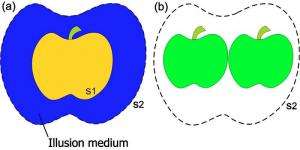April 2, 2010 feature
Invisibility cloak that generates virtual images gets closer to realization

(�鶹��ԺOrg.com) -- In a twist on the concept of an invisibility cloak, researchers have designed a material that not only makes an object invisible, but also generates one or more virtual images in its place. Because it doesn't simply display the background environment to a viewer, this kind of optical device could have applications that go beyond a normal invisibility cloak. Plus, unlike previously proposed illusion devices, the design proposed here could be realized with artificial metamaterials.
The team of engineers, Wei Xiang Jiang, Hui Feng Ma, Qiang Cheng, and Tie Jun Cui from Southeast University in Nanjing, China, describes the recently developed class of optical transformation media as “illusion media.” As they explain in a new study, any object enclosed by such an illusion medium layer appears to be one or more other objects. The researchers’ proposed device is designed to operate at microwave frequencies.
“The illusion media make an enclosed object appear like another object or multiple virtual objects,” Cui told �鶹��ԺOrg.com. “Hence it can be applied to confuse the detectors or the viewers, and the detectors or the viewers can’t perceive the real object. As a result, the enclosed object will be protected.”
As the researchers explain, illusion media is similar to an invisibility cloak, except for one main difference. In a perfect invisibility cloak, there are almost no scattering electric fields, so that the illusion space is only free space. In illusion media, on the other hand, the material creates scattered electric field patterns that generate virtual images. Any detector located outside the illusion medium layer will perceive the electromagnetic waves as if they were scattered from a virtual object.
“Generally speaking, different objects will generate different scattering patterns under the illumination of electromagnetic/optical waves,” Ciu explained. “Hence a detector can perceive an object according to its scattering pattern. Our illusion media will change the scattering patterns of the enclosed object to make it appear like another object or multiple virtual objects.”
The new illusion media design has an advantage over previously proposed illusion media, in that it should be easier to fabricate. As Ciu explains, this ability is due to how the illusion medium is constructed.
“The general concept of our illusion media is similar to that of previous illusion media,” Cui said. “However, the previously proposed illusion media are two distinct pieces of metamaterials, which are called complementary medium and restoring medium. The complementary medium is composed of left-handed materials with simultaneously negative permittivity and permeability. As a result, the proposed illusion device is extremely demanding of material parameters, and is hardly realized. Our purpose is to make the illusion media be fairly realizable. All permittivity and permeability components of our illusion media are finite and positive. Hence the presented approach makes it possible to realize the illusion media using artificial metamaterials.”
More information: Wei Xiang Jiang, Hui Feng Ma, Qiang Cheng, and Tie Jun Cui. “Illusion media: Generating virtual objects using realizable metamaterials.” Applied �鶹��Ժics Letters 96, 121910 (2010).
Copyright 2010 �鶹��ԺOrg.com.
All rights reserved. This material may not be published, broadcast, rewritten or redistributed in whole or part without the express written permission of �鶹��ԺOrg.com.
















